Applications
Vegetable & Flower Beds:
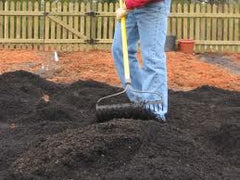 Spread 1/2-1" over area and incorporate with other amendments to 4"-6". Wet down the biochar and amendments after you have added them. If you have raised beds, biochar only need be added to those areas. Typically this is a one-time addition of biochar, and ideally less less amendments will be needed the next seasons due to biochar's ability to hold on to nutrients.
Spread 1/2-1" over area and incorporate with other amendments to 4"-6". Wet down the biochar and amendments after you have added them. If you have raised beds, biochar only need be added to those areas. Typically this is a one-time addition of biochar, and ideally less less amendments will be needed the next seasons due to biochar's ability to hold on to nutrients.
Starts, Seedlings & Plugs:
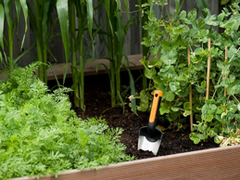 Lay a thick line of biochar along the planting line & dibber or trowel into the seeding medium prior to planting seedlings or plugs. No more than 10% biochar is required with other amendments. Water after incorporating the seeds/plugs or starts. Having seeds exposed early on to biochar gives them the best possible start at germination and growth.
Lay a thick line of biochar along the planting line & dibber or trowel into the seeding medium prior to planting seedlings or plugs. No more than 10% biochar is required with other amendments. Water after incorporating the seeds/plugs or starts. Having seeds exposed early on to biochar gives them the best possible start at germination and growth.
Trees:
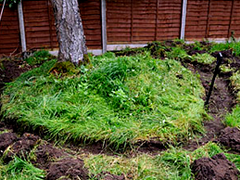 Make a trench at least 4' deep around the tree's "dripline" - the drip line refers to the areas you would get, once the tree has reached its mature size, if you drew a circle on the soil corresponding to the size of the tree's crown. Apply biochar as close to tree's root zone as possible. For trees you can also us an "air excavation tool".Then cover with compost, other amendments and soil.
Make a trench at least 4' deep around the tree's "dripline" - the drip line refers to the areas you would get, once the tree has reached its mature size, if you drew a circle on the soil corresponding to the size of the tree's crown. Apply biochar as close to tree's root zone as possible. For trees you can also us an "air excavation tool".Then cover with compost, other amendments and soil.
Hydroponics:
 Add 1 tablespoon of Black Owl Powdered Activated Biochar (TM) to 1 quart to your liquid nutrients. "BOB" Powdered Activated Biochar has exceptional cation exchange capacity micronized powdered product. This product has been used in controlled trials with liquid nutrients and the results were substantial, greater roots, more vigorous plants, and greater budding.
Add 1 tablespoon of Black Owl Powdered Activated Biochar (TM) to 1 quart to your liquid nutrients. "BOB" Powdered Activated Biochar has exceptional cation exchange capacity micronized powdered product. This product has been used in controlled trials with liquid nutrients and the results were substantial, greater roots, more vigorous plants, and greater budding.
Pots:
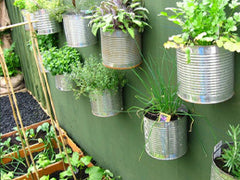
For seeding trays, dust on BOB Powdered Activated Biochar, in the seed row. Make sure the powder is in contact with the base of the trough so it will be in contact with the seeds rooting area. For filling flats or media for pots, add 5-10% BOB's Pure and Natural Ag/Hort Biochar. The addition of biochar increases aeration and water exchange with the roots. It makes nutrients more bioavailable.
Lawns & Turf:
 Aerate mechanically or use forks with tines to make 3"-4" holes. Use lawn fertilizer spreader or sprinkle in biochar to fill the holes. Water in. The biochar will spread out on its own. Typically this is also a one time application and less amendments as well as water will be needed each season.
Aerate mechanically or use forks with tines to make 3"-4" holes. Use lawn fertilizer spreader or sprinkle in biochar to fill the holes. Water in. The biochar will spread out on its own. Typically this is also a one time application and less amendments as well as water will be needed each season.
Composting:
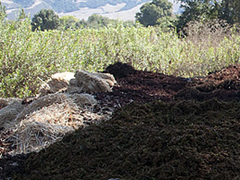 In a tumbling composter, mix 10% biochar by volume and incorporate into the composting process. For pile composting shake a layer of biochar with each addition of organic material. The addition of biochar will speed up the composting process, reduce odors, and ultimate give you a higher-quality compost. Ideally, you would add the biochar early in the state of composting.
In a tumbling composter, mix 10% biochar by volume and incorporate into the composting process. For pile composting shake a layer of biochar with each addition of organic material. The addition of biochar will speed up the composting process, reduce odors, and ultimate give you a higher-quality compost. Ideally, you would add the biochar early in the state of composting.
Targeted applications:
 Where precise data on soil characteristics and farm machinery equipped with geographical positioning is available, it is possible to apply biochar preferentially to areas of fields where fertility is low or drought or water-logging challenges exist. Efficacy can be seen at as low as 3% application. Premix biochar with other amendments prior to adding to machinery.
Where precise data on soil characteristics and farm machinery equipped with geographical positioning is available, it is possible to apply biochar preferentially to areas of fields where fertility is low or drought or water-logging challenges exist. Efficacy can be seen at as low as 3% application. Premix biochar with other amendments prior to adding to machinery.
